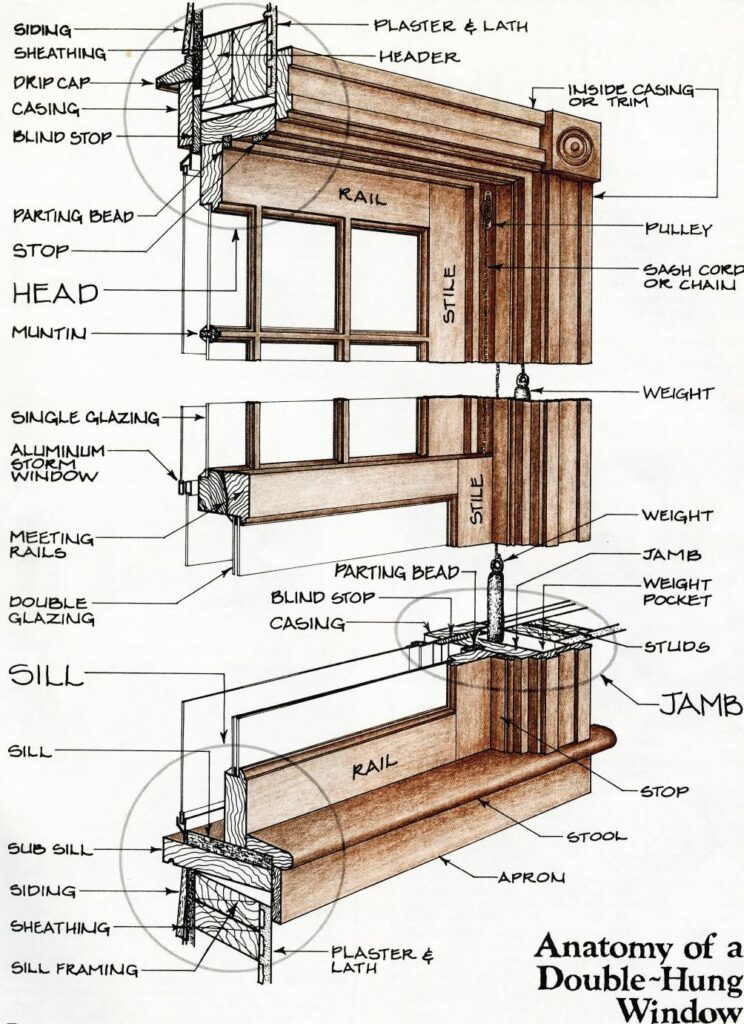Glossary
The Anatomy of a Historic Double-Hung Window
Windows have a lot of parts, and each has a name. We came across this old drawing called "Anatomy of a Double Hung Window". Here you are looking at the inside of what is one of the most common styles of windows we find in old homes that were built before 1960. While the glass and sticking patterns can vary, the basic mechanical operation of all double-hung windows is essentially the same. This picture combined with our descriptions below should help anyone attempting to identify parts of these windows.

The following are common descriptions of words often used during a window restoration project:
Apron
Trim that runs along the interior wall under the stool.
Blind Stop
Exterior element that holds the upper sash from falling outward.
Brickmold
Exterior casing covering most of the blind stop that is adjacent to brick.
Casing
Exterior trim that covers most of the blind stop.
Double Hung
Window configuration with an upper and lower sash that both freely slide up and down, each attached to it's own balance mechanism.
Drip Cap
Protective molding, or flashing, over window head. Keeps water from running directly onto the window from above.
Glazing Points
Small pieces of metal that hold the glass in the sash before and while the glazing putty is applied.
Glazing Putty
The putty that holds glass into the window sash.
Interior Stop
Interior trim along the inside vertical edges of the lower sash.
Jamb
Framing on the side of a window that the sash slide up and down along.
Meeting Rail
The place where the upper rail on the lower sash and the lower rail of the upper sash meet where the window lock hardware is usually attached in double hung window configurations.
Mullion
A structural muntin that spans from one side of a sash to the other.
Muntin
Decorative element in a sash which divides the glass into different shapes. Can be a variety of patterns and profiles.
Parting Bead
Also known as parting stop. This is the molding separating tracks in which ride the upper and lower sash. Keeps sash from rubbing against each other.
Pulley
The sash cord or chain travels from it's attachment on the sash over this into the weight pocket where weights are attached which balances the sash and allows the window to operate smoothly.
Rail
The horizontal frame parts of a window sash.
Realignment
The process of adjusting the parts of a window so that the sash line up properly.
Re-string
The process of replacing the sash cord on the lower or upper sash.
Sash
The portion of the window which holds the glass. Sash can be fixed in place, or move in a variety of styles. The jamb and stops can provide a track for the operation of a hung sash.
Sash Cord or Chain
Cotton rope or metal chain that attaches the sash to the weights by running over a pulley near the top of the jamb.
Sill
The bottom piece of an opening that the lower sash rests on when closed.
Single Hung
Window configuration with a fixed upper sash and freely sliding lower sash attached to a balance mechanism.
Stile
The vertical sides of a window sash
Stool
Interior trim piece that forms a ledge at the bottom of the lower sash when closed.
Storm Window
Protective covering for window unit that protects the window from weather and air infiltration.
Sub Sill
Supporting piece under the sill. Often made from wood, concrete, or stone.
Weatherstrip
Material used between sash and jamb to allow the sash to slide more smoothely and decrease air infiltration.
Weight Pocket
Pocket of space behind jamb for the weights to raise and lower within.
Weights
Each sash has a pair equal in weight that are attached to create smooth operation in both raising and lowering the sash.

